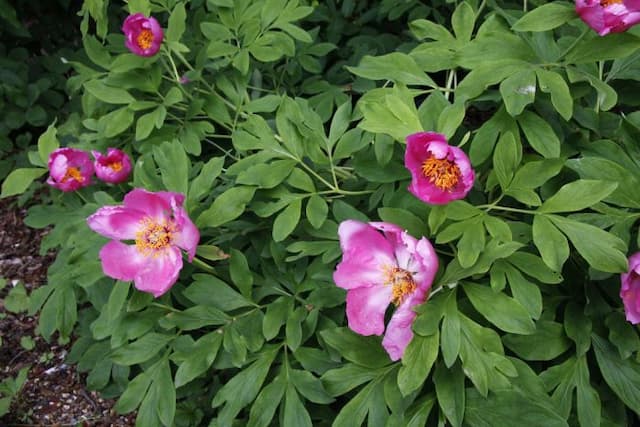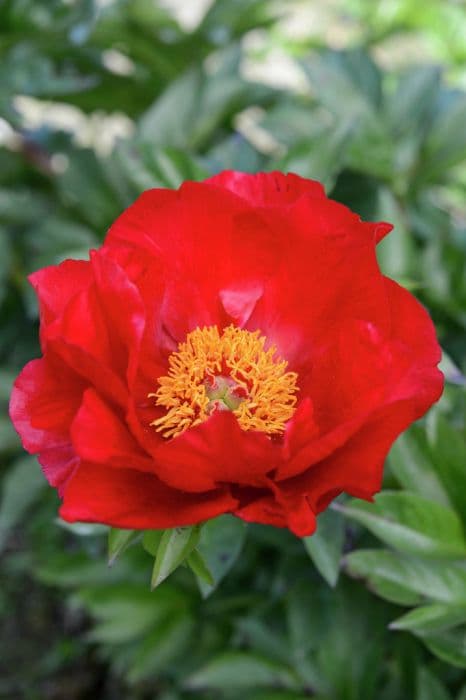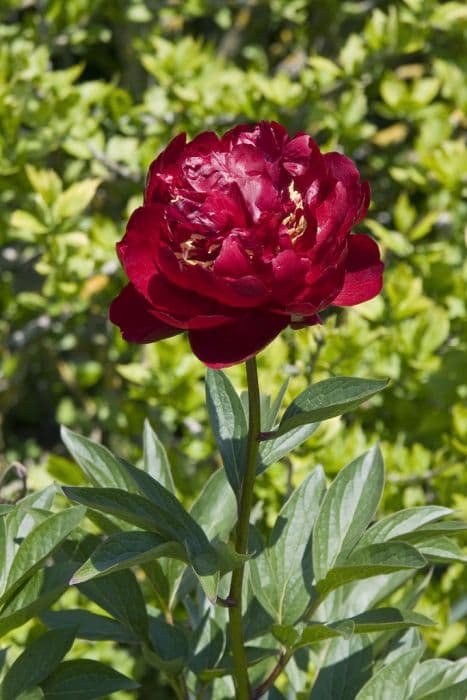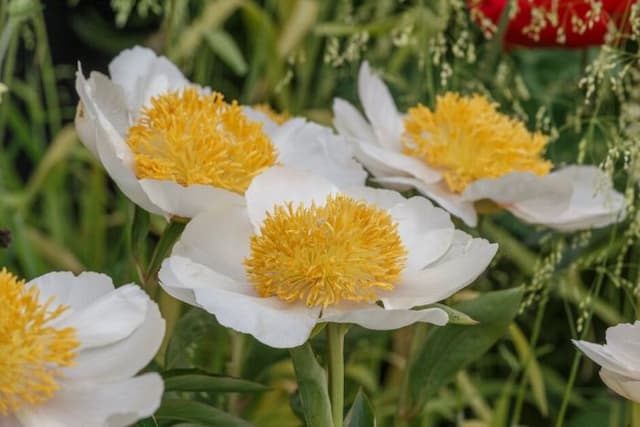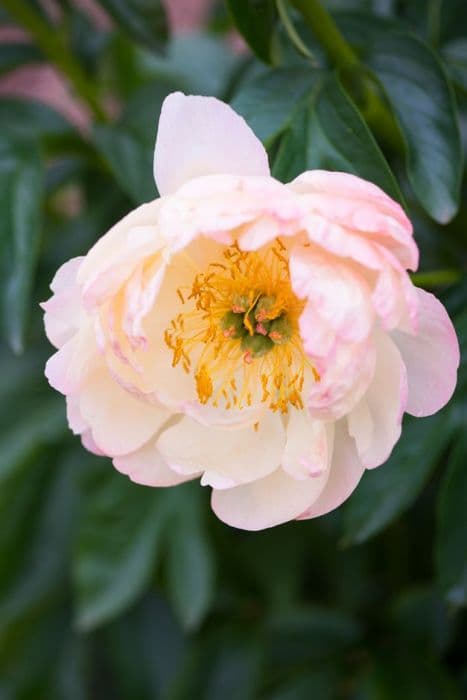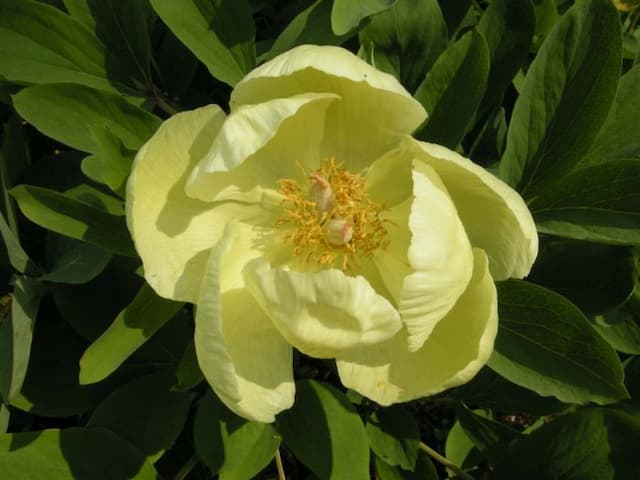Peony Paeonia 'Flame'

ABOUT
The Peony 'Flame' is a strikingly beautiful perennial plant known for its flamboyant blooms. Its distinguishing feature is its large, bowl-shaped flowers that bear a warm, vibrant pink color with a slightly coral hue, giving the impression of glowing embers. The broad, silky petals are slightly ruffled at the edges and form a rounded cup, which envelops a prominent center of golden yellow stamens that add a stark contrast to the pink petals. The blossoms emit a delightful fragrance that is both sweet and intoxicating, luring in onlookers as well as pollinators like bees and butterflies. The foliage of the Peony 'Flame' is deep green, composed of compound leaves divided into lobed leaflets that provide a lush backdrop for the spectacular flowers. The leaves are glossy, adding a textural quality to the visual display. The plant presents its flamboyant flowers on top of sturdy stems that rise up amidst the bushy clump of foliage. As the season progresses and after the flowering period, Peony 'Flame' continues to provide visual interest in the garden with its attractive foliage, which may take on hues of bronze or red as the cooler weather approaches. While providing incredible aesthetic appeal during bloom time, this peony variety also contributes to the overall structure and texture of the garden throughout the growing season.
About this plant
 Names
NamesFamily
Paeoniaceae
Synonyms
Peony, Flame Peony
Common names
Paeonia 'Flame'.
 Toxicity
ToxicityTo humans
The Peony, specifically the variety Paeonia 'Flame', is not considered highly toxic to humans. However, it can cause some gastrointestinal upset if ingested, such as nausea or diarrhea. The main potential concern is skin irritation, as peonies contain a compound called paeonol, which can cause a rash or skin irritation after handling the plant, particularly in sensitive individuals.
To pets
Peonies, including Paeonia 'Flame', are considered mildly toxic to pets, such as dogs and cats. If ingested, they can cause gastrointestinal upset in pets, which may manifest as symptoms like vomiting or diarrhea. It's advisable to keep your pets from ingesting any part of the plant to prevent these potential issues.
 Characteristics
CharacteristicsLife cycle
Perennials
Foliage type
Deciduous
Color of leaves
Green
Flower color
Red
Height
2-3 feet (0.6-0.9 meters)
Spread
2-3 feet (0.6-0.9 meters)
Plant type
Shrub
Hardiness zones
3-8
Native area
Asia
Benefits
 General Benefits
General Benefits- Attractive Blooms: Paeonia 'Flame', commonly known as peony, produces vibrant, flame-colored flowers that enhance the beauty of any garden setting.
- Longevity: Peonies are perennial plants, meaning they can live and bloom year after year, offering long-term enjoyment.
- Drought Tolerance: Once established, peonies are quite drought-tolerant, reducing the need for frequent watering.
- Low Maintenance: Peonies require minimal care once they are settled in, making them a low-maintenance choice for gardeners.
- Cold Hardy: Peonies are capable of withstanding cold temperatures, making them suitable for gardens in many climates.
- Attracts Pollinators: The flowers attract bees and other pollinators, supporting local ecosystems.
- Deer Resistance: Peonies are often resistant to deer, making them an excellent choice for gardens in areas with high deer populations.
- Versatile Landscaping: Peonies can be used in a variety of landscaping designs, including borders, as specimen plants, or in mass plantings.
- Cut Flowers: The blossoms of peonies are popular for use in cut flower arrangements, providing beauty indoors as well as outdoors.
 Medical Properties
Medical PropertiesThis plant is not used for medical purposes.
 Air-purifying Qualities
Air-purifying QualitiesThis plant is not specifically known for air purifying qualities.
 Other Uses
Other Uses- Artistic Inspiration: Paeonia 'Flame', commonly known as Peony, has a vibrant color and form that can inspire artists and photographers, often becoming the subject of paintings, illustrations, and photography projects.
- Garden Design: Peonies can be used in garden design to create focal points or to add a splash of early summer color, enhancing the aesthetic appeal of private and public gardens.
- Wedding Decor: The bright and showy flowers of 'Flame' Peonies are prized for creating romantic and elegant wedding bouquets, centerpieces, and venue decorations.
- Fragrance Extraction: Although less common than with some other flowers, the scent of Peonies may be captured and used in the production of perfumes and scented products.
- Eco-Friendly Confetti: Dried petals from Peonies can be used as a biodegradable option for confetti at celebrations, reducing environmental impact.
- Dye Production: The pigments from Peony petals can be used to produce natural dyes for fabric, yarn, or paper, offering shades of pink, red, and sometimes yellow depending on the mordant used.
- Culinary Garnish: While not a common practice, the petals of Peonies can be used as an ornate and edible garnish on desserts and specialty dishes in high-end culinary presentations.
- Feng Shui: In some cultures, Peonies are believed to symbolize prosperity and good fortune, and they may be planted or used in arrangements to promote positive energy in homes and businesses.
- Biomonitoring: Peonies can be used in environmental biomonitoring as indicators of seasonal changes or the presence of certain pollutants by observing their growth patterns and flowering times.
- Educational Use: The life cycle and growth of Peonies, which include distinct phases from bud to bloom to seed, can serve as an educational tool in horticultural studies and botanical science programs.
Interesting Facts
 Feng Shui
Feng ShuiThe Peony is often used in Feng Shui to attract love, romance, and positive relationship chi, especially when placed in the southwest corner of the garden or home.
 Zodiac Sign Compitability
Zodiac Sign CompitabilityThe Peony is not used in astrology practice.
 Plant Symbolism
Plant Symbolism- Romance and Love: The Paeonia 'Flame' or commonly known as Peony, is often associated with romance and passionate love, possibly due to its vibrant and full blossoms that symbolize the fiery aspect of love.
- Prosperity and Good Fortune: Peonies are considered a good omen for prosperity and good fortune, making them popular in celebrations such as weddings and festivities.
- Honor and Wealth: With its lush, opulent petals, the Peony can also represent honor and the luxury of wealth, embodying abundance and success.
- Beauty and Femininity: The delicate appearance of the flower is connected to beauty and femininity, celebrating the grace and elegance of women.
- Compassion: Peonies may signify compassion as they bring joy and are often given to convey comfort and sympathy to others.
- Happy Marriage: Due to their use in weddings and their full, rounded blooms, Peonies are believed to signify a happy marriage, embodying the ideal of a union filled with prosperity and respect.
 Water
WaterFor the Peony 'Flame', it is essential to maintain even moisture, especially during the growing season. Water these plants deeply once a week, providing about one inch of water each time, which translates to roughly 0.623 gallons for each peony plant. Avoid overhead watering to prevent fungal diseases; instead, water at the base of the plant early in the morning. During periods of drought or extreme heat, you may need to water twice a week. Reduce watering as the plant goes dormant in the fall.
 Light
LightPeony 'Flame' requires full sun to bloom at its best, meaning at least six hours of direct sunlight per day. Plant it in a location where it can receive unfiltered morning light and some protection from the harsh afternoon sun to avoid scorching the delicate blooms. A spot with early to midday sun exposure is ideal for this plant.
 Temperature
TemperatureThe Peony 'Flame' thrives in temperatures that are consistent with temperate regions. It can survive winter temperatures down to -20°F but prefers the growing season to have temperatures between 65°F and 75°F. Ensure it's planted in an area that doesn't exceed 85°F for extended periods as high heat can stunt growth and reduce blooming.
 Pruning
PruningPrune Peony 'Flame' after the blooming season, usually in late summer or early fall, to remove spent flowers and deadhead. This encourages future blooms and prevents seed production, which can divert energy from the plant. Cut back foliage to the ground in the fall after frost has caused the leaves to die back, which helps prevent disease and prepares the plant for winter. Annual pruning is sufficient for maintaining healthy growth and vibrant blooms.
 Cleaning
CleaningAs needed
 Soil
SoilPeonies such as 'Flame' prefer well-drained, fertile soil rich in organic matter. A good soil mix for peonies would include equal parts of garden soil, compost, and perlite or coarse sand to ensure proper drainage. The soil pH should be neutral to slightly alkaline, ranging from 6.5 to 7.5 for optimal growth.
 Repotting
RepottingPeonies like 'Flame' typically do not need to be repotted often. They are long-lived perennials that can thrive in the same location for years. It’s generally recommended to divide or repot these peonies only if the clumps become too large or if they are not flowering well, which might occur every 10 to 15 years.
 Humidity & Misting
Humidity & MistingPeonies, including the 'Flame' variety, are tolerant of a range of humidity levels and do not require any special humidity considerations. They grow well in the typical outdoor humidity levels found in their hardiness zones and do not require the humidity levels to be adjusted for optimal growth.
 Suitable locations
Suitable locationsIndoor
Ensure bright light, cool winter conditions, and plant in deep pots.
Outdoor
Plant in full sun with rich, well-draining soil; water moderately.
Hardiness zone
3-8 USDA
 Life cycle
Life cycleThe peony 'Flame' starts its life cycle as a dormant tuberous root, typically planted in the fall. As spring approaches, it breaks dormancy and sprouts red-tinted shoots that develop into large, divided leaves. By late spring or early summer, the plant reaches the flowering stage, showcasing its vibrant, flame-colored blooms that attract pollinators. After pollination, the flowers may develop into seed pods if not deadheaded. During the summer, the plant stores energy in its roots for the next season before the foliage yellows and dies back with the onset of autumn. The peony 'Flame' then enters a period of dormancy in winter, conserving energy underground to complete the cycle and re-emerge the following spring.
 Propogation
PropogationPropogation time
Spring to early summer
The Paeonia 'Flame', commonly known as the Flame Peony, is typically propagated by division, a popular method for many herbaceous peonies. Division is best done in the fall when the plant has died back and is dormant. A mature Flame Peony, around 3-5 years old, should be carefully dug up, taking care to preserve as much of the root system as possible. The roots should be divided into sections ensuring that each piece has 3 to 5 buds, often referred to as "eyes". These sections can then be replanted in well-drained soil with the eyes situated 1 to 2 inches (about 2.5 to 5 centimeters) below the soil surface, spaced about 3 feet (approximately 91 centimeters) apart to allow sufficient room for growth. Water thoroughly after planting to help establish the root system. This method encourages a high success rate and helps to rejuvenate older plants.
